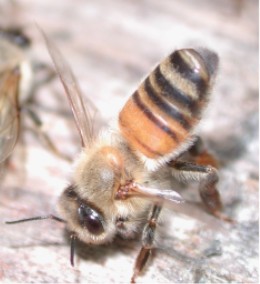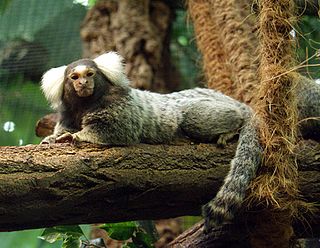
A pheromone is a secreted or excreted chemical factor that triggers a social response in members of the same species. Pheromones are chemicals capable of acting like hormones outside the body of the secreting individual, to affect the behavior of the receiving individuals. There are alarm pheromones, food trail pheromones, sex pheromones, and many others that affect behavior or physiology. Pheromones are used by many organisms, from basic unicellular prokaryotes to complex multicellular eukaryotes. Their use among insects has been particularly well documented. In addition, some vertebrates, plants and ciliates communicate by using pheromones. The ecological functions and evolution of pheromones are a major topic of research in the field of chemical ecology.

Sexual attraction is attraction on the basis of sexual desire or the quality of arousing such interest. Sexual attractiveness or sex appeal is an individual's ability to attract other people sexually, and is a factor in sexual selection or mate choice. The attraction can be to the physical or other qualities or traits of a person, or to such qualities in the context where they appear. The attraction may be to a person's aesthetics, movements, voice, or smell, among other things. The attraction may be enhanced by a person's adornments, clothing, perfume or hair style. It can be influenced by individual genetic, psychological, or cultural factors, or to other, more amorphous qualities. Sexual attraction is also a response to another person that depends on a combination of the person possessing the traits and on the criteria of the person who is attracted.
Concealed ovulation or hidden estrus in a species is the lack of any perceptible change in an adult female when she is fertile and near ovulation. Some examples of perceptible changes are swelling and redness of the genitalia in baboons and bonobos, and pheromone release in the feline family. In contrast, the females of humans and a few other species that undergo hidden estrus have few external signs of fecundity, making it difficult for a mate to consciously deduce, by means of external signs only, whether or not a female is near ovulation.

Pygmy marmosets are two species of small New World monkeys in the genus Cebuella. They are native to rainforests of the western Amazon Basin in South America. These primates are notable for being the smallest monkeys in the world, at just over 100 g (3.5 oz). They are generally found in evergreen and river-edge forests and are gum-feeding specialists, or gummivores.

In the zoological field of ethology, a dominance hierarchy is a type of social hierarchy that arises when members of animal social groups interact, creating a ranking system. A dominant higher-ranking individual is sometimes called an alpha, and a submissive lower-ranking individual is called a beta. Different types of interactions can result in dominance depending on the species, including ritualized displays of aggression or direct physical violence. In social living groups, members are likely to compete for access to limited resources and mating opportunities. Rather than fighting each time they meet, individuals of the same sex establish a relative rank, with higher-ranking individuals often gaining more access to resources and mates. Based on repetitive interactions, a social order is created that is subject to change each time a dominant animal is challenged by a subordinate one.

The common marmoset also called white-tufted marmoset or white-tufted-ear marmoset is a New World monkey. It originally lived on the northeastern coast of Brazil, in the states of Piaui, Paraiba, Ceará, Rio Grande do Norte, Pernambuco, Alagoas, and Bahia. Through release of captive individuals, it has expanded its range since the 1920s to Southeast Brazil, where it became an invasive species, raising concerns about genetic pollution of similar species, such as the buffy-tufted marmoset, and predation upon bird nestlings and eggs.
Cooperative breeding is a social system characterized by alloparental care: offspring receive care not only from their parents, but also from additional group members, often called helpers. Cooperative breeding encompasses a wide variety of group structures, from a breeding pair with helpers that are offspring from a previous season, to groups with multiple breeding males and females (polygynandry) and helpers that are the adult offspring of some but not all of the breeders in the group, to groups in which helpers sometimes achieve co-breeding status by producing their own offspring as part of the group's brood. Cooperative breeding occurs across taxonomic groups including birds, mammals, fish, and insects.

In animals, infanticide involves the intentional killing of young offspring by a mature animal of the same species. Animal infanticide is studied in zoology, specifically in the field of ethology. Ovicide is the analogous destruction of eggs. The practice has been observed in many species throughout the animal kingdom, especially primates but including microscopic rotifers, insects, fish, amphibians, birds and mammals. Infanticide can be practiced by both males and females.

Neolamprologus pulcher is a species of cichlid endemic to Lake Tanganyika where it prefers locations with plenty of sedimentation. The common names for N. pulcher include daffodil cichlid, fairy cichlid, princess of Zambia and lyretail cichlid. This species can reach a length of 10 centimetres (3.9 in) TL. It can also be found in the aquarium trade.

Eusociality, the highest level of organization of sociality, is defined by the following characteristics: cooperative brood care, overlapping generations within a colony of adults, and a division of labor into reproductive and non-reproductive groups. The division of labor creates specialized behavioral groups within an animal society which are sometimes referred to as 'castes'. Eusociality is distinguished from all other social systems because individuals of at least one caste usually lose the ability to perform at least one behavior characteristic of individuals in another caste. Eusocial colonies can be viewed as superorganisms.
The Bruce effect, or pregnancy block, is the tendency for female rodents to terminate their pregnancies following exposure to the scent of an unfamiliar male. The effect was first noted in 1959 by Hilda M. Bruce, and has primarily been studied in laboratory mice. In mice, pregnancy can only be terminated prior to embryo implantation, but other species will interrupt even a late-term pregnancy.
Odour is sensory stimulation of the olfactory membrane of the nose by a group of molecules. Certain body odours are connected to human sexual attraction. Humans can make use of body odour subconsciously to identify whether a potential mate will pass on favourable traits to their offspring. Body odour may provide significant cues about the genetic quality, health and reproductive success of a potential mate.

Within the insect order Hymenoptera, the Halictinae are the largest, most diverse, and most recently diverged of the four halictid subfamilies. They comprise over 2400 bee species belonging to the five taxonomic tribes Augochlorini, Thrinchostomini, Caenohalictini, Sphecodini, and Halictini, which some entomologists alternatively organize into the two tribes Augochlorini and Halictini.

Sexual swelling, sexual skin, or anogenital tumescence refers to localized engorgement of the anus and vulva region of some female primates that vary in size over the course of the menstrual cycle. Thought to be an honest signal of fertility, male primates are attracted to these swellings; preferring, and competing for, females with the largest swellings.

Social monogamy in mammals is defined as sexually mature adult organisms living in pairs. While there are many definitions of social monogamy, this social organization can be found in invertebrates, reptiles and amphibians, fish, birds, mammals, and humans.
Inbreeding avoidance, or the inbreeding avoidance hypothesis, is a concept in evolutionary biology that refers to the prevention of the deleterious effects of inbreeding. Animals only rarely exhibit inbreeding avoidance. The inbreeding avoidance hypothesis posits that certain mechanisms develop within a species, or within a given population of a species, as a result of assortative mating and natural and sexual selection, in order to prevent breeding among related individuals. Although inbreeding may impose certain evolutionary costs, inbreeding avoidance, which limits the number of potential mates for a given individual, can inflict opportunity costs. Therefore, a balance exists between inbreeding and inbreeding avoidance. This balance determines whether inbreeding mechanisms develop and the specific nature of such mechanisms.

In behavioral ecology, polyandry is a class of mating system where one female mates with several males in a breeding season. Polyandry is often compared to the polygyny system based on the cost and benefits incurred by members of each sex. Polygyny is where one male mates with several females in a breeding season . A common example of polyandrous mating can be found in the field cricket of the invertebrate order Orthoptera. Polyandrous behavior is also prominent in many other insect species, including the red flour beetle and the species of spider Stegodyphus lineatus. Polyandry also occurs in some primates such as marmosets, mammal groups, the marsupial genus' Antechinus and bandicoots, around 1% of all bird species, such as jacanas and dunnocks, insects such as honeybees, and fish such as pipefish.
Infanticide in non-human primates occurs when an individual kills its own or another individual's dependent young. Five hypotheses have been proposed to explain infanticide in non-human primates: exploitation, resource competition, parental manipulation, sexual selection, and social pathology.
The ovulatory shift hypothesis holds that women experience evolutionarily adaptive changes in subconscious thoughts and behaviors related to mating during different parts of the ovulatory cycle. It suggests that what women want, in terms of men, changes throughout the menstrual cycle. Two meta-analyses published in 2014 reached opposing conclusions on whether the existing evidence was robust enough to support the prediction that women's mate preferences change across the cycle. A newer 2018 review does not show women changing the type of men they desire at different times in their fertility cycle.

Primate sociality is an area of primatology that aims to study the interactions between three main elements of a primate social network: the social organisation, the social structure and the mating system. The intersection of these three structures describe the socially complex behaviours and relationships occurring among adult males and females of a particular species. Cohesion and stability of groups are maintained through a confluence of factors, including: kinship, willingness to cooperate, frequency of agonistic behaviour, or varying intensities of dominance structures.



















